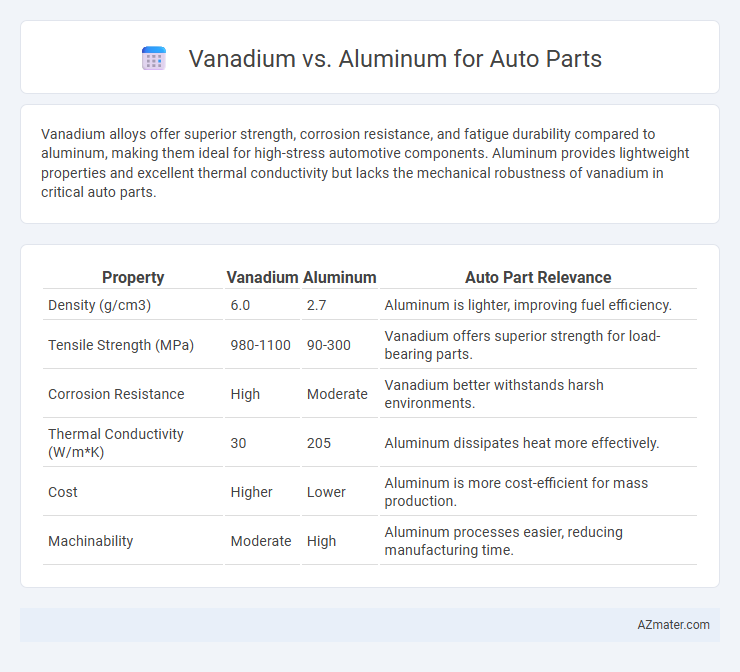Vanadium alloys offer superior strength, corrosion resistance, and fatigue durability compared to aluminum, making them ideal for high-stress automotive components. Aluminum provides lightweight properties and excellent thermal conductivity but lacks the mechanical robustness of vanadium in critical auto parts.
Table of Comparison
| Property | Vanadium | Aluminum | Auto Part Relevance |
|---|---|---|---|
| Density (g/cm3) | 6.0 | 2.7 | Aluminum is lighter, improving fuel efficiency. |
| Tensile Strength (MPa) | 980-1100 | 90-300 | Vanadium offers superior strength for load-bearing parts. |
| Corrosion Resistance | High | Moderate | Vanadium better withstands harsh environments. |
| Thermal Conductivity (W/m*K) | 30 | 205 | Aluminum dissipates heat more effectively. |
| Cost | Higher | Lower | Aluminum is more cost-efficient for mass production. |
| Machinability | Moderate | High | Aluminum processes easier, reducing manufacturing time. |
Introduction to Vanadium and Aluminum in Automotive Applications
Vanadium and aluminum play critical roles in automotive manufacturing, with vanadium primarily used as an alloying element in high-strength steel to improve durability and wear resistance, essential for engine components and suspension systems. Aluminum's lightweight properties make it ideal for reducing overall vehicle weight, enhancing fuel efficiency, and improving handling in parts such as engine blocks, body panels, and wheels. The combination of vanadium-enhanced steel and aluminum alloys contributes significantly to the balance between strength, weight reduction, and performance in modern automotive design.
Material Properties: Vanadium vs Aluminum
Vanadium exhibits superior strength, hardness, and corrosion resistance compared to aluminum, making it ideal for high-stress auto parts such as crankshafts and gears. Aluminum offers lightweight properties with good thermal conductivity and adequate strength, preferred for components like engine blocks and body panels where weight reduction is critical. The choice between vanadium and aluminum depends on balancing durability and weight efficiency in automotive applications.
Strength and Durability Comparison
Vanadium alloys exhibit superior strength and durability compared to aluminum, making them ideal for high-stress auto parts such as suspension components and engine valves. The high tensile strength of vanadium, often enhanced through alloying with steel, provides better wear resistance and fatigue life than aluminum, which is lighter but more prone to deformation under heavy loads. Aluminum's corrosion resistance and lighter weight contribute to fuel efficiency, but vanadium's mechanical properties ensure longer-lasting performance in critical automotive applications.
Weight Considerations in Auto Parts
Vanadium alloys offer superior strength-to-weight ratios compared to aluminum, enabling lighter yet more durable auto parts critical for vehicle performance and fuel efficiency. Aluminum remains popular for its low density (2.7 g/cm3) and excellent corrosion resistance, contributing to significant weight reduction over traditional steel components. However, vanadium-enhanced steel alloys, despite slightly higher density (around 6-6.2 g/cm3), deliver enhanced mechanical properties, allowing thinner, lighter components that meet rigorous automotive weight and safety standards.
Corrosion Resistance and Longevity
Vanadium alloys exhibit superior corrosion resistance compared to aluminum, especially in harsh automotive environments where exposure to moisture and chemicals is prevalent. The addition of vanadium enhances the material's strength and oxidation resistance, resulting in longer-lasting auto parts that maintain integrity under stress. Aluminum offers lightweight benefits but generally requires protective coatings to achieve comparable longevity in corrosive conditions.
Manufacturing and Processing Differences
Vanadium, used primarily as an alloying element in steel production, significantly enhances strength and wear resistance, making it ideal for high-stress automotive components, whereas aluminum offers superior lightweight properties essential for fuel efficiency. Manufacturing with vanadium steel requires high-temperature forging and precise heat treatment to optimize mechanical performance, while aluminum parts benefit from casting, extrusion, and advanced machining techniques due to their excellent formability. Processing vanadium alloys involves more energy-intensive steps and higher tooling costs compared to aluminum, which facilitates faster production cycles and reduced vehicle weight for improved handling and emissions.
Cost Analysis: Vanadium vs Aluminum
Vanadium alloys typically exhibit higher material costs compared to aluminum due to the rarity and complex extraction process of vanadium, impacting overall auto part production expenses. Aluminum offers cost advantages with abundant supply and lower processing energy requirements, making it economically favorable for mass-produced vehicle components. However, vanadium's superior strength-to-weight ratio can justify its premium price in performance-critical auto parts, balancing initial costs through enhanced durability and reduced weight-related fuel consumption.
Environmental Impact and Sustainability
Vanadium's use in auto parts enhances vehicle strength and durability, leading to longer-lasting components that reduce waste and resource consumption over time. Aluminum, known for its lightweight properties, contributes to improved fuel efficiency and lower emissions during vehicle operation, supporting reduced carbon footprints. While aluminum production is energy-intensive, recycling aluminum requires significantly less energy, making it a more sustainable option when sourced from recycled material compared to vanadium's more complex extraction processes.
Performance in Real-World Automotive Scenarios
Vanadium alloys offer superior strength-to-weight ratios and enhanced fatigue resistance compared to aluminum, crucial for high-stress automotive components like suspension systems and engine parts. In real-world scenarios, vanadium's ability to maintain structural integrity under extreme temperatures and repeated load cycles results in longer-lasting, more reliable auto parts. Aluminum, while lighter and more cost-effective, often falls short in durability and performance under rigorous driving conditions, making vanadium a preferred choice for critical performance applications.
Conclusion: Choosing the Right Material for Auto Parts
Vanadium offers exceptional strength and wear resistance, making it ideal for high-stress automotive components like suspension and engine parts, while aluminum provides lightweight advantages critical for fuel efficiency and reducing vehicle mass. Selecting the right material depends on balancing mechanical performance with weight considerations, where vanadium alloys suit durability-focused applications and aluminum alloys optimize overall vehicle efficiency. Careful evaluation of part function and performance requirements ensures the optimal material choice for automotive manufacturing.

Infographic: Vanadium vs Aluminum for Auto Part
 azmater.com
azmater.com